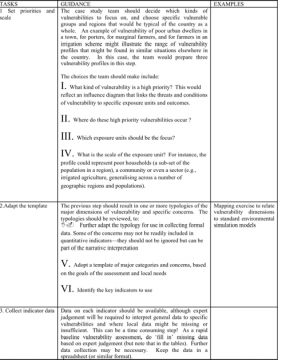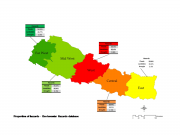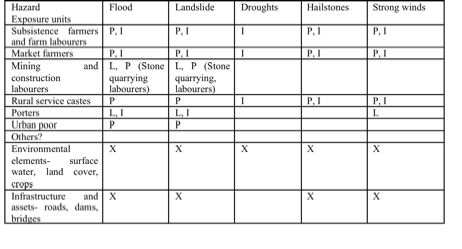Nepal Vulnerability Assessment

The process begins with vulnerability exposure analysis. This links to a participatory exercise on defining scenarios of the reference vulnerability (changes in exposure unit), climatic stresses and sensitivity of the exposure unit to each stress. The outcome provides some conclusions regarding coping strategies, vulnerability indices and adaptation options.
In the ACCCA pilot action proposal one of the expected outcomes is a weather and climate related information dissemination scheme. This will be generic for the Nepalese context so that it can be applied in all 400 existing CBDP (Community Based Disaster Preparedness) Units of Nepal Red Cross Society. As part of the outreach and communication the following is proposed : WCID is an area where insurance agencies in Nepal have not introduced their schemes yet. The following outreach techniques will be used in the project: Weather and climate alerts, weather and climate related information, weather and climate information related to disaster prone zones and historical disaster patterns and climate change data will be published in the format of maps and charts understandable to local people. This information will help the community to task preventative and adaptive measures and help to decide on risk-based premiums.
This is the rationale for including both local information where possible for the Syangia district along with district level information for the whole country.
Vulnerability assessment
A baseline vulnerability assessment of a country can ensure that climate change is taken into account in development planning and decision-making processes. The purpose is to identify risks that may be exacerbated by climate change and to evaluate their effects at present and in the future. Highlighting the location of key hotspots in a country through a risk assessment is important in identifying areas for intervention and can also inform the insurance process of present and future risks. This allows the responses available to be prioritised and compared equitably with other risks, resource availability and cost issues. This process will support the work of ACCCA which is focused on a specific area – the Putalibazaar Municipality of Syangia and help to identify regions which are similar in terms of their vulnerability and exposure to hazards to this region and also their suitability to the micro-insurance scheme. For example a quick look at this process begins with identifying the major climate hazards, identifying which populations are at risk and how frequently the hazards occur.
A matrix of vulnerable groups or livelihoods and their relative exposure to different threats can be constructed through a participatory process with the community of interest alongside information already available through previous assessment such as the FAO/WFP Food Security Assessment Mission to Nepal (FAO, WFP 2007) and the Comprehensive Food Security and Vulnerability Analysis (UNWFP, 2005). This stage has not been conducted in detail for the country as a whole but an example is given below. Regions and exposure to hazards within the country can then be compared using indicators through vulnerability maps.
An example of groups vulnerable to food insecurity is included in the table below and their possible exposure to weather related climate hazards.
Extreme events such as flooding, landslides, droughts, heat stress, hot winds, cold waves, hail storms and snowfalls are undesirable; in recent years, their frequency seems to have increased noticeably in the country, and long dry spells and cold waves have negatively affected the crop production.
Some simple steps that can be used to identify indicators of vulnerability and shown below (taken from AVA Assessment of Vulnerability for Adaptation, SEI, 2005).
1. Identification of the priorities and scales of assessment and exposure units
2. Review and adapt the indicator template to suit local needs; identify the key indicators to use and the broader attributes of vulnerability
3. Collect data on each indicator; use expert judgement where local data might be missing or insufficient
4. Compile profiles of the indicators.

Table of steps

Proportion of hazards
As this paper is focused on climate hazards it is necessary to construct an exposure matrix when the exposure unit and climate threats are identified. For example the Nepal NAPA project profile identifies marginal farmers in the three topographical regions- mountain, hill and Terai and then rural service castes, porters and urban poor as vulnerable to food insecurity. These groupings will be used here along with some additions based on occupation. The climatic threats can then be listed as shown in the table below.

Exposure matrix illustration
Using this table it is possible to score the threats (say on a scale of 1 to 5). Also different symbols could be used to indicate the nature of the exposure such as: • Direct impact on life/ health (L) • Direct impact on property (P) • Financial effects of increased expenditure or reduced income (I) • Psychological or social stress • General impact (X)
From this table it is possible to identify which exposure units should be the focus and what is the scale of the exposure unit. Is it possible to identify specific exposure units that can represent the broader vulnerability of the country?
Related Pages
Background to ACCCA Nepal Project
Background on Disasters in Nepal
Identifying Climatic Hazards in Nepal
Understanding trends in climate in Nepal
Developing quantitative indices for Nepal
Other work on Adaptation in Nepal:
(0) Comments
There is no content